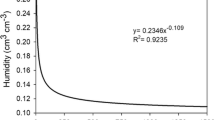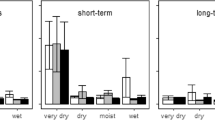Abstract
The objectives of this study were to test the existence of osmotic adjustment in a field-grown chickpea (Cicer arietinum L.) and to reproduce it in controlled conditions for a more complete study. In a first experiment, carried out in the field with the cultivar Casoar, we described two types of drought stress that a field-grown chickpea could experience during flowering in our conditions. They were characterized with soil and plant water status. Osmotic adjustment was taking place when the stress increased progressively. This evidence was obtained with the measurement of plant water potential and relative water content during a drying-rewatering cycle. In a second experiment, carried out in pots with rain shelter, with cultivars Casoar and Sombrero, we reproduced this particular type of drought stress, on the basis of soil water potential. Measurement of plant water status was based on water, osmotic, and turgor potentials, and relative water content. It showed that chickpea is able to realize osmotic adjustment during a controlled drying-rewatering cycle limited in intensity and duration. The analysis of a broad range of solutes (nitrate, sucrose, glucose, proline, malic acid and six other organic acids) gave a good explanation of the measured reduction of osmotic potential. Organic acids accounted for most of this reduction: 97% for Casoar and 96% for Sombrero. Malic acid, which represented about half of these acids, and malonic acid significantly accumulated during the drought stress. They explained 78.2% (for Casoar) and 75.8% (for Sombrero) of the reduction of osmotic potential. Cultivar Sombrero was the only one able to accumulate some sucrose.
Similar content being viewed by others
References
Bennett J M, Cortes P M and Lorens G F 1986 Comparison of water potential components measured with a thermocouple psychrometer and a pressure chamber and the effects of starch hydrolysis. Agron. J. 78, 239–244.
Bensari M, Calmès J and Viala G 1990 Répartition du carbone fixé par photosynthèse entre l'amidon et le saccharose dans la feuille de soja. Influence d'un déficit hydrique. Plant Physiol. Biochem. 28, 113–121.
Blum A 1989 Osmotic adjustment and growth of barley genotypes under drought stress. Crop Sci. 29, 230–233.
Fournier C 1989 Réponse à la sécheresse d'une légumineuse soumise à deux régimes azotés différents. D.E.A. Sciences Agronomiques, USTL Montpellier II.
Henricksen A and Semer-Olsen A B 1970 Automatic method for determining nitrate and nitrate reduction in water and soil extracts. Analyst 95, 514–518.
Koundal K R and Sinha S K 1983 Evaluation of the significance of malic acid secretion in chickpea. Plant Physiol. 58, 189–192.
Ludlow M N and Muchow R C 1990 A critical evaluation of traits for improving crop yields in water-limited environments. Adv. Agron. 43, 107–153.
Morgan J M 1983 Osmoregulation as a criterion for drought tolerance in wheat. Aus. J. Agric. Res. 34, 607–614.
Morgan J M 1984 Osmoregulation and water stress in higher plants. Annu. Rev. Plant Physiol. 35, 299–319.
Morgan J M, Rodriguez-Maribona B and Knights E J 1991 Adaptation to water-deficit in chickpea breeding lines by osmoregulation: Relationship to grain yield in the field. Field Crops Res. 27, 61–70.
Saxena M C 1990 Status of chickpea in the mediterranean basin. In Options Mediterranéennes. Serie Séminaires No. 9. pp 17–24. CIHEAM Paris.
Saxena N P 1987 Screening for adaptation to drought: Case studies with chickpea and pigeonpea. In Adaptation of Chickpea and Pigeonpea to Abiotic Stresses. Proceedings of the Consultant's Workshop, 19–21 December 1984. pp 63–76. ICRISAT Center, India, Patancheru, A.P. 502 324, India, ICRISAT.
Sinclair T R and Ludlow M M 1986 Influence of soil water supply on the plant water balance of four tropical grain legumes. Aust. J. Plant Physiol. 13, 329–341.
Touraine B and Astruc S 1990 Purification and dual-column HPLC determination of carboxylic acids in tissues, phloem and xylem saps of soybean plants. Chromatographia 30, 388–392.
Troll W and Lindsley J 1955 A photometric method for determination of proline. J. Biol. Chem. 215, 655–660.
Turc O, Wery J and Sao Chan Cheong G 1990 A limited drought stress as a tool for the management of the balance between vegetative and reproductive components of peas. In Proc. First Congress ESA. Paris. 5–7 December 1990. Ed. A Scaife. ESA, Paris.
Turner N C 1981 Techniques and experimental approaches for the measurement of plant water status. Plant and Soil 58, 339–366.
Turner N C 1986a Adaptation to water deficit: A changing perspective. Aust. J. Plant Physiol. 13, 175–190.
Turner N C 1986b Crop water deficits: A decade of progress. Adv. Agron. 39, 1–51.
Wery J 1990 Adaptation to frost and drought stress in chickpea and implications in plant breeding. In Options CIHEAM, Paris.
Zhang Hong-Qi and Croes A F 1983 Protection of pollen germination from adverse temperatures: A possible role for proline. Plant Cell. Environ. 6, 471–476.
Author information
Authors and Affiliations
Rights and permissions
About this article
Cite this article
Lecoeur, J., Wery, J. & Turc, O. Osmotic adjustment as a mechanism of dehydration postponement in chickpea (Cicer arietinum L.) leaves. Plant Soil 144, 177–189 (1992). https://doi.org/10.1007/BF00012874
Received:
Issue Date:
DOI: https://doi.org/10.1007/BF00012874




